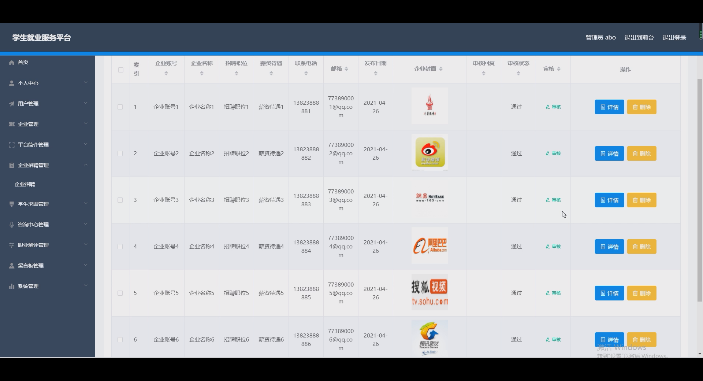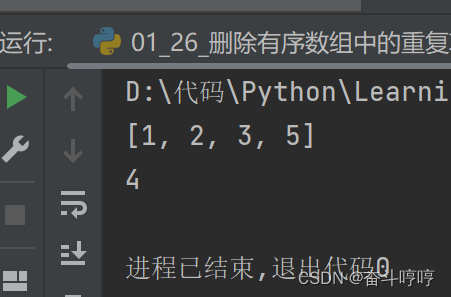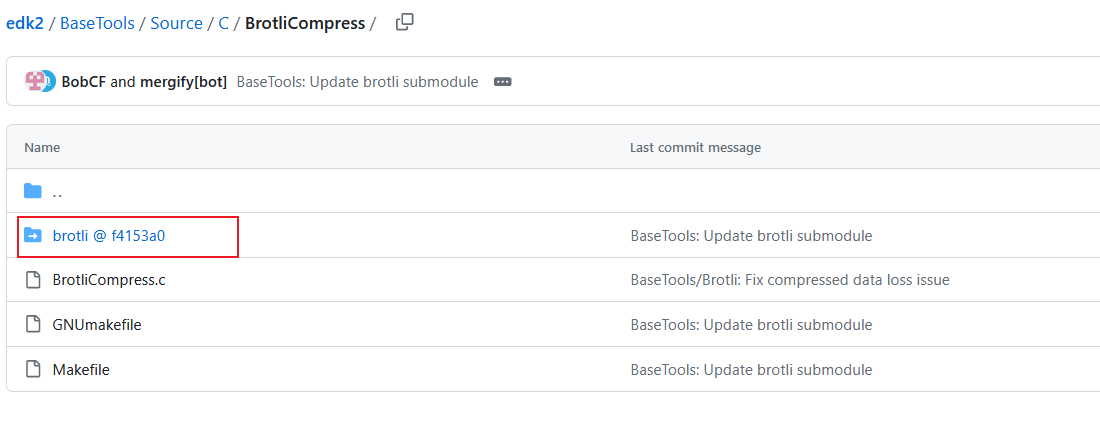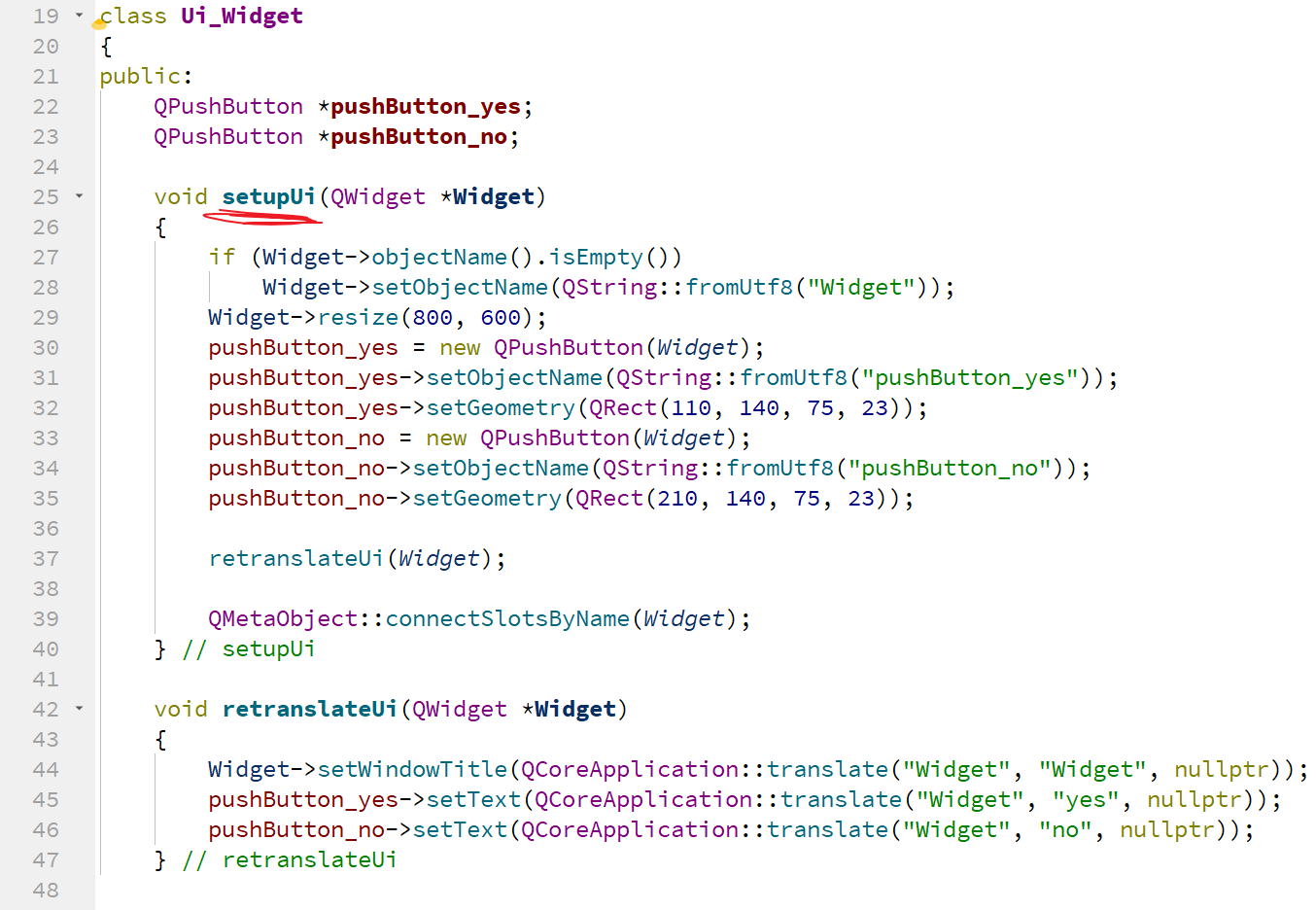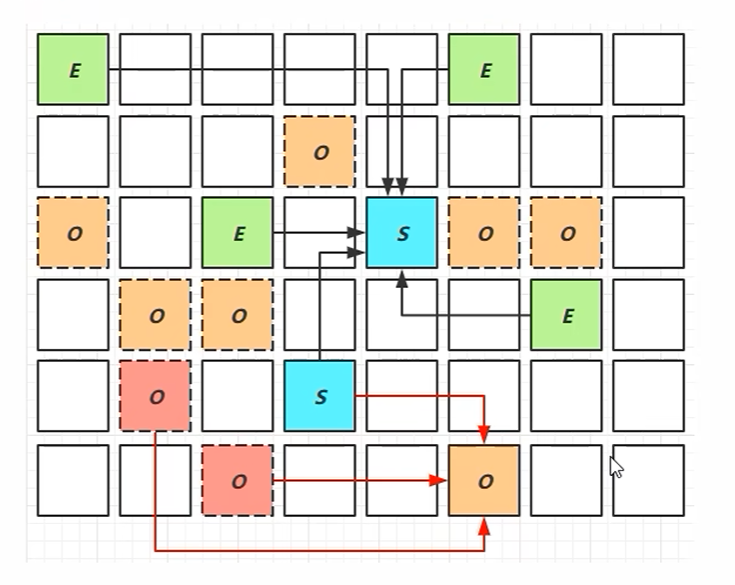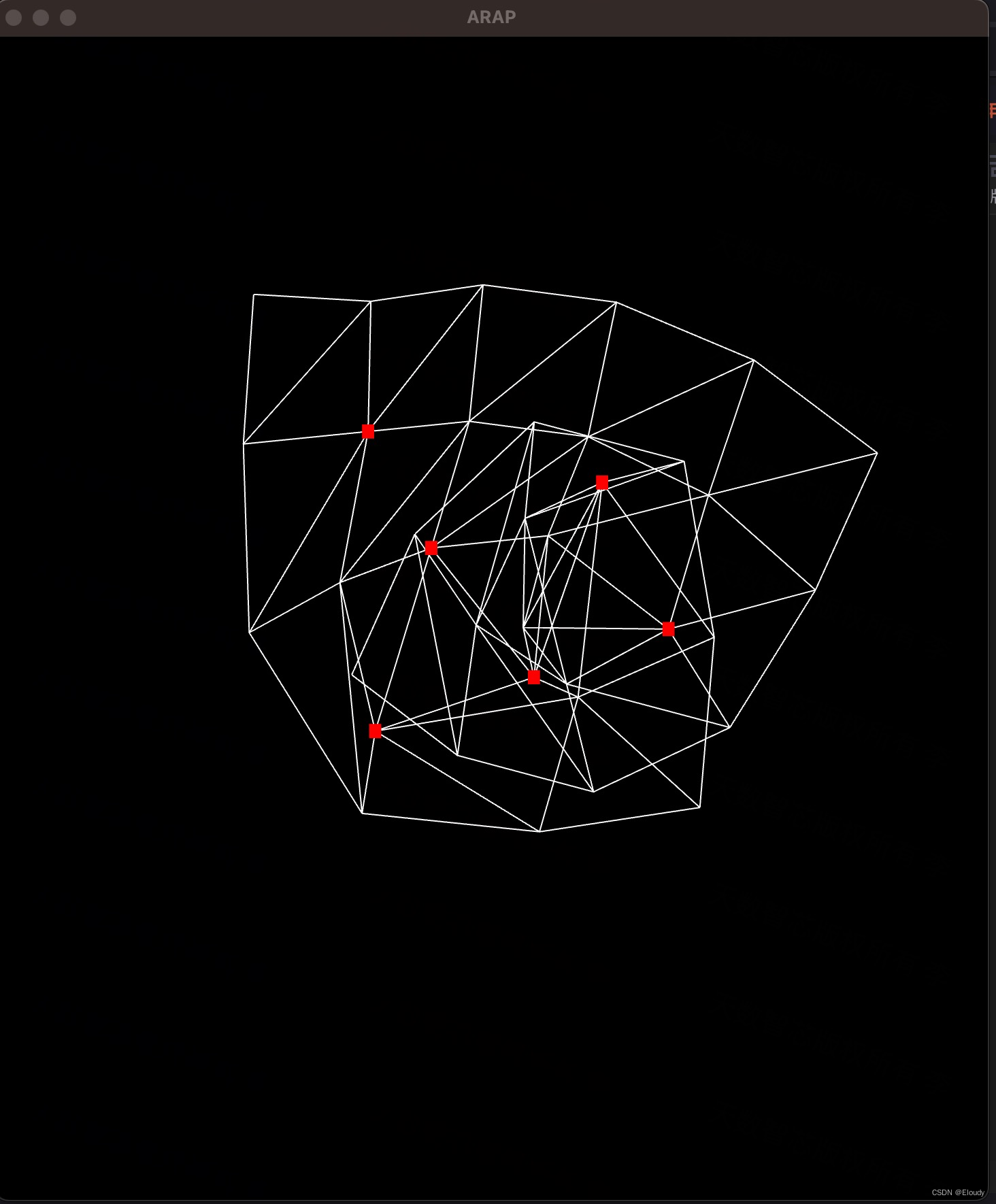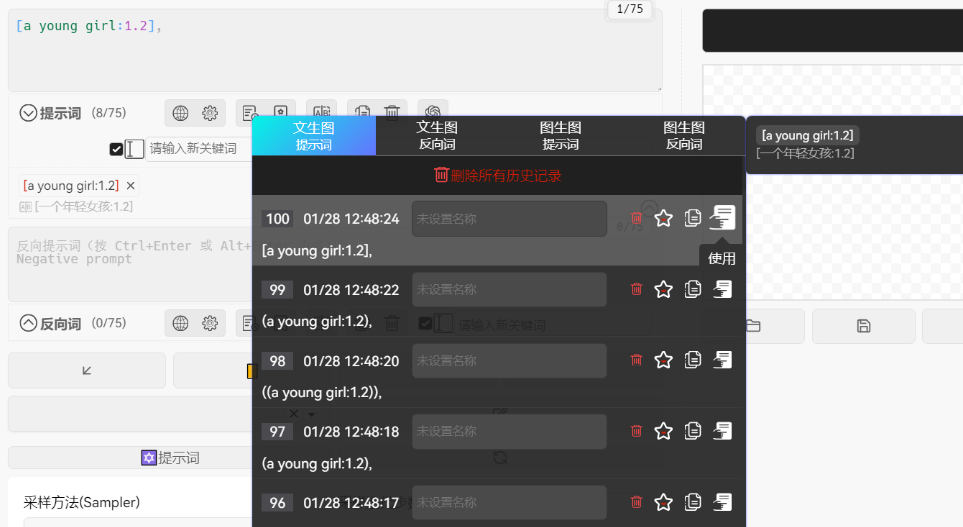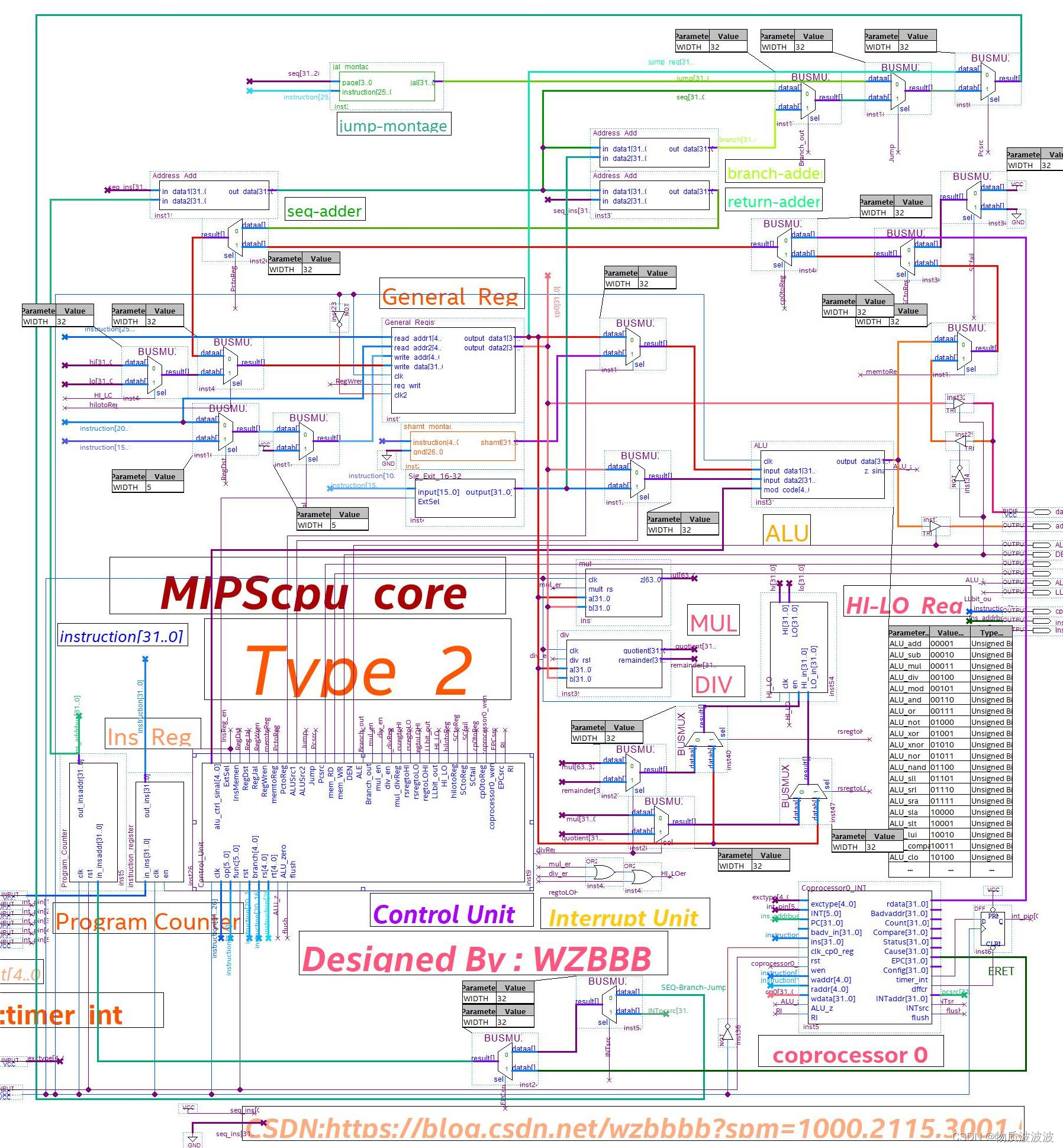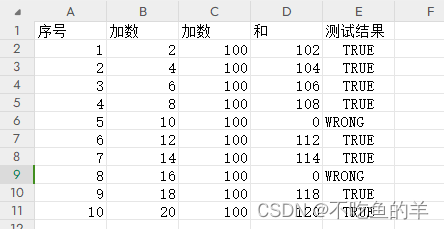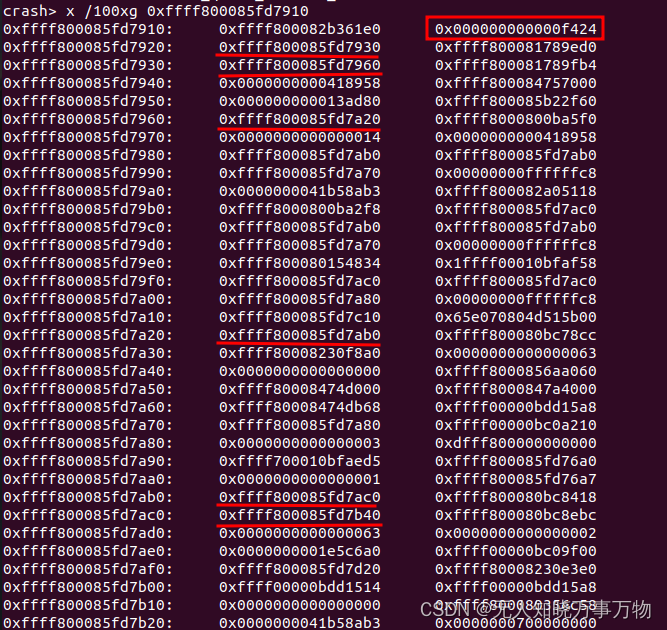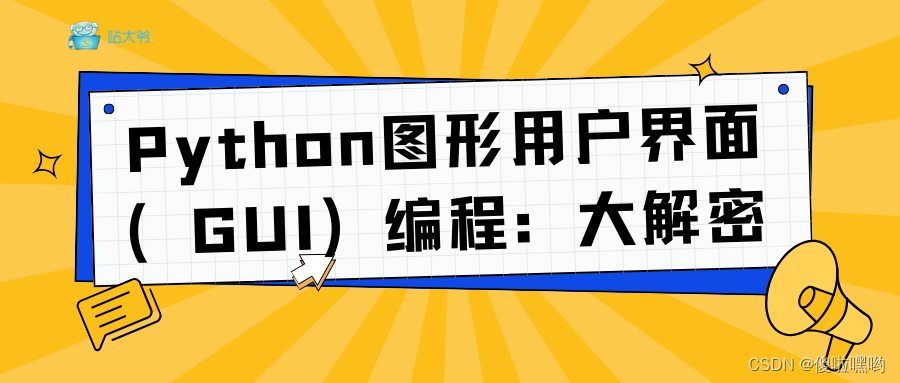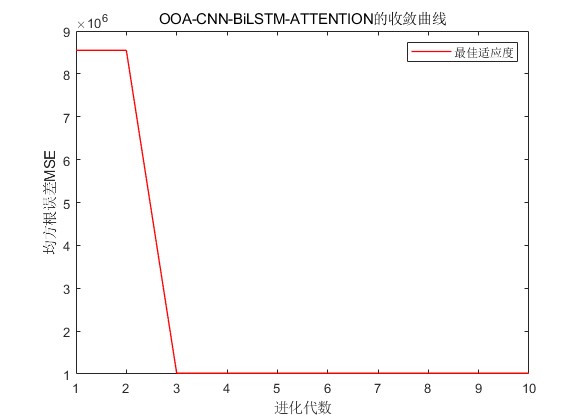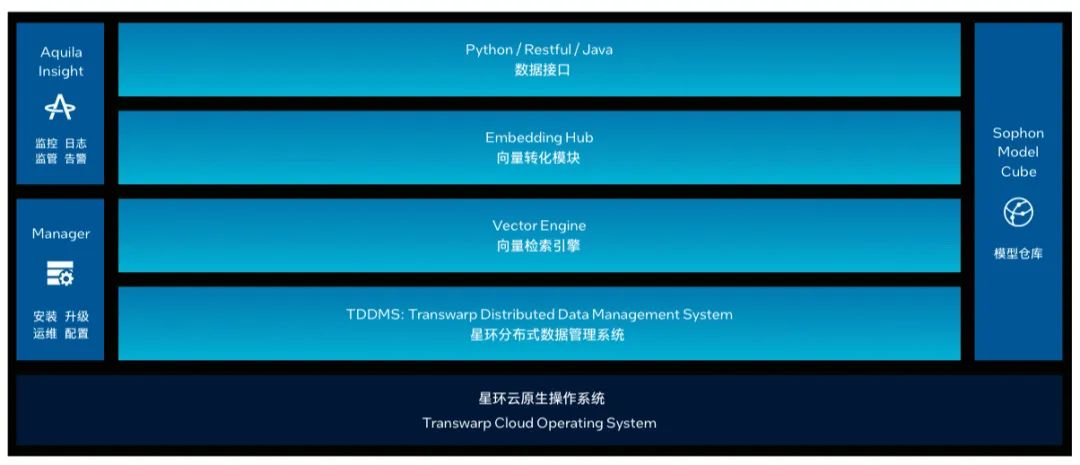一、模型搭建
导入包、全局设置
import numpy as np
import os
%matplotlib inline
import matplotlib
import matplotlib.pyplot as plt
plt.rcParams['axes.labelsize'] = 14
plt.rcParams['xtick.labelsize'] = 12
plt.rcParams['ytick.labelsize'] = 12
import warnings
warnings.filterwarnings('ignore')
np.random.seed(42)(1)import os
os 模块提供了与操作系统交互的方式,允许你执行与文件和目录操作、环境变量等相关的各种操作。
(2)%matplotlib inline
%matplotlib inline 是一个特殊的 Jupyter Notebook 魔术命令(magic command)。它告诉 Jupyter 在 notebook 中直接显示 matplotlib 绘制的图表,而不需要使用 plt.show()。
这一行代码通常在 Jupyter Notebook 中的代码单元格的顶部使用,以确保图表能够直接嵌入到 notebook 中。在其他的 Python 开发环境中,这一行代码可能不是必需的,因为图表可能会在独立的窗口中显示。
(3)import warnings
warnings.filterwarnings('ignore')
是一个用于设置警告过滤器的语句,它指示 Python 在运行时忽略所有警告。
(4)np.random.seed(42)
设置 NumPy 随机数生成器种子的命令。这一行代码的作用是使得随机数生成变得可重复。通过指定相同的种子,你可以确保在每次运行程序时生成的随机数序列是相同的。
(5)plt.rcParams['axes.labelsize'] = 14
plt.rcParams['xtick.labelsize'] = 12
plt.rcParams['ytick.labelsize'] = 12
rcParams 是 Matplotlib 中的一个参数配置字典,用于控制图形的默认属性。这个字典包含了许多用于配置图形元素的键值对,如字体大小、颜色、线型等。通过修改这些参数,可以全局地改变 Matplotlib 图形的默认外观。 通过修改 rcParams 中的一些键值对,实现了全局地设置了坐标轴标签和刻度标签的字体大小。这样,之后绘制的所有图形都会遵循这些字体大小的设定,除非在特定图形的绘制代码中有显式的覆盖。
数据集读取
(1)mnist_784数据集
from sklearn.datasets import fetch_openml
mnist = fetch_openml('mnist_784')从OpenML存储库中获取了标识符为'mnist_784'的MNIST数据集。该数据集包含28x28像素的手写数字(0到9)的灰度图像。每个图像被展平为一个包含784个(28 * 28)特征的1D数组。fetch_openml函数返回一个类似字典的对象(sklearn.utils.Bunch),其中包含数据、目标标签和与数据集相关的其他信息。
(2)数据集预处理
i、将训练集洗牌
ii、将多分类变为二分类(数字是否为5)
X, y = mnist.data, mnist.target
X_train, X_test, y_train, y_test = X[:60000], X[60000:], y[:60000], y[60000:]
# 洗牌操作
import numpy as np
shuffle_index = np.random.permutation(60000)
y_train, X_train = y_train.loc[shuffle_index], X_train.loc[shuffle_index]
#将多分类转换为2分类
y_train_5 = (y_train=='5')
y_test_5 = (y_test=='5')
模型建立
from sklearn.linear_model import SGDClassifier
sgd_clf = SGDClassifier(max_iter=5,random_state=42)
sgd_clf.fit(X_train,y_train_5)(1)SGDClassifier分类器
SGD 是 "Stochastic Gradient Descent" 的缩写,中文翻译为 "随机梯度下降"。在机器学习中,梯度下降是一种优化算法,用于最小化损失函数,从而使模型能够学到适当的参数。
在 SGDClassifier 中,该算法被用于训练线性分类器,以对数据进行分类。
(2)粗略验证模型
sum(sgd_clf.predict(X_train) == y_train_5)
#输出为:57370
sum(sgd_clf.predict(X_test) == y_test_5)
#输出为:9592
sum(sgd_clf.predict(X) == (y == '5'))
#输出为:66962二、模型评估
交叉验证cross_val_score
(1)cross_val_score函数实现
from sklearn.model_selection import cross_val_score
cross_val_score(sgd_clf,X_train,y_train_5,cv=3,scoring='accuracy')
#输出为:array([0.964 , 0.9579, 0.9571])(2)自己编写交叉验证(理解即可,仅为描述cross_val_score的实现过程)
from sklearn.model_selection import StratifiedKFold
from sklearn.base import clone
skflods = StratifiedKFold(n_splits=3,random_state=42,shuffle=True)
for train_index,test_index in skflods.split(X_train,y_train_5):
clone_clf = clone(sgd_clf)
X_train_folds = X_train.loc[train_index]
y_train_folds = y_train_5[train_index]
X_test_folds = X_train.loc[test_index]
y_test_folds = y_train_5[test_index]
clone_clf.fit(X_train_folds,y_train_folds)
y_pred = clone_clf.predict(X_test_folds)
n_correct = sum(y_pred == y_test_folds)
print(n_correct/len(y_pred))(1)
from sklearn.model_selection import StratifiedKFold
from sklearn.base import clone
这两行代码导入了 StratifiedKFold 类和 clone 函数,它们分别用于分层折叠交叉验证和克隆模型。
(2)
skflods = StratifiedKFold(n_splits=3,random_state=42,shuffle=True)
这一行创建了一个 StratifiedKFold 对象,用于执行分层折叠交叉验证。参数说明:
n_splits=3:指定了折叠的数量,这里是 3 折。random_state=42:设置了随机种子,以确保交叉验证的可重复性。shuffle=True:表示在每次划分前是否洗牌(打乱样本的顺序)。
(3)
for train_index, test_index in skfolds.split(X_train, y_train_5):
这一行通过 skfolds.split 方法迭代每个折叠,返回训练集和测试集的索引。train_index 和 test_index 是当前折叠的训练数据和测试数据的索引。
(4)
for train_index, test_index in skfolds.split(X_train, y_train_5):
这一行使用 clone 函数创建了 SGDClassifier 模型的一个克隆。clone 函数确保了克隆的模型和原始模型是相互独立的,对一个模型的更改不会影响另一个。
(5)
X_train_folds = X_train.loc[train_index]
y_train_folds = y_train_5[train_index]
X_test_folds = X_train.loc[test_index]
y_test_folds = y_train_5[test_index]
这几行通过索引从原始的 X_train 和 y_train_5 数据中获取了当前折叠的训练数据和测试数据。
(6)
clone_clf.fit(X_train_folds, y_train_folds)
这一行使用当前折叠的训练数据对克隆的模型进行训练。
(7)
y_pred = clone_clf.predict(X_test_folds)
这一行使用训练后的模型对当前折叠的测试数据进行预测。
(8)
n_correct = sum(y_pred == y_test_folds)
accuracy = n_correct / len(y_pred)
print(accuracy)
这几行计算了当前折叠的准确度。n_correct 记录了正确预测的数量,然后通过除以测试集样本数量得到准确度,并打印出来。这样,你就可以得到每个折叠的模型性能。这个过程在整个循环中会重复执行,每次迭代都是一个新的折叠。
混淆矩阵
(1)cross_val_predict函数
功能:交叉验证并返回预测标签。在使用 cross_val_predict 时,需要提供一个已经初始化的模型(例如 SGDClassifier 或其他分类器/回归器)。然后,cross_val_predict 会根据指定的交叉验证折叠策略(cv 参数)多次拆分数据集,对每个折叠使用指定的模型进行训练和预测。
from sklearn.model_selection import cross_val_predict
y_train_pred = cross_val_predict(sgd_clf,X_train,y_train_5,cv=3)
y_train_pred[:10]
#输出为:array([False, False, False, False, False, False, False, False, True, False])(2)得到混淆矩阵
from sklearn.metrics import confusion_matrix
cm = confusion_matrix(y_train_5,y_train_pred)
cm
#输出为:array([[54058, 521],
# [1899, 3522]], dtype=int64)[[ **true negatives** , **false positives** ],
[ **false negatives** , **true positives** ]]
* true negatives: 54058个数据被正确的分为非5类别
* false positives:521张被错误的分为5类别
* false negatives:1899张错误的分为非5类别
* true positives: 3522张被正确的分为5类别
一个完美的分类器应该只有**true positives** 和 **true negatives**, 即主对角线元素不为0,其余元素为0
(3)展示混淆矩阵
from sklearn.metrics import ConfusionMatrixDisplay
disp = ConfusionMatrixDisplay(confusion_matrix=cm)
disp.plot()
plt.show()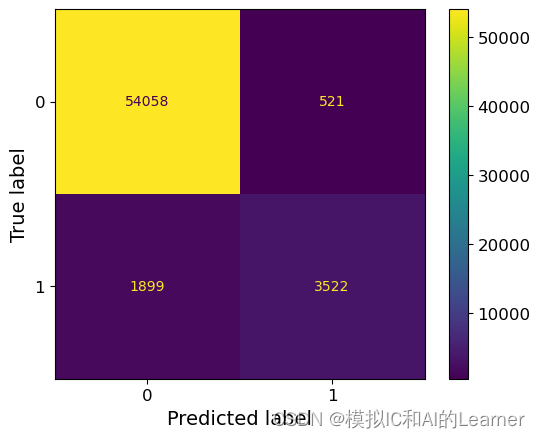
准确率、召回率和 “F1得分”
准确率:模型预测的正确率
召回率:模型预测对目标的找出能力
F1得分:两者的调和平均
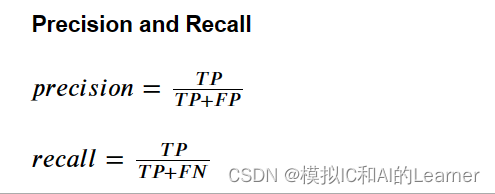
将Precision 和 Recall结合到一个称为F1 score 的指标,调和平均值给予低值更多权重。 因此,如果召回和精确度都很高,分类器将获得高F 1分数。

from sklearn.metrics import precision_score,recall_score
precision_score(y_train_5,y_train_pred)
#输出为:0.8711352955725946
recall_score(y_train_5,y_train_pred)
#输出为:0.6496956281128943
from sklearn.metrics import f1_score
f1_score(y_train_5,y_train_pred)
#输出为:0.7442941673710904阈值对结果的影响
(1)decision_function()方法
Scikit-Learn不允许直接设置阈值,但它可以得到决策分数,调用其decision_function()方法,而不是调用分类器的predict()方法,该方法返回每个实例的分数,然后使用想要的阈值根据这些分数进行预测:
y_scores = sgd_clf.decision_function(X_train[:10])
y_scores
#输出为:array([-558596.64281983, -359729.00538583, -273844.96590398,
# -502105.55813185, -507402.81825564, -629069.60120174,
# -441083.42849022, -155220.78442829, 105466.65971603,
# -579296.81125892])
t = 0
y_pred = (y_scores > t)
y_pred
#输出为:array([False, False, False, False, False, False,
# False, False, True, False])(2)cross_val_predict() 方法
y_scores = cross_val_predict(sgd_clf, X_train, y_train_5, cv=3,
method="decision_function")
y_scores[:10]
#输出为:array([ -545086.1906455 , -200238.20632717, -366873.76172794,
# -648828.94558457, -572767.52239341, -1016184.25580999,
# -419438.40135302, -171080.39957192, 237230.03978349,
# -793932.50331372])(3)准确率召回率曲线
from sklearn.metrics import precision_recall_curve
precisions, recalls, thresholds = precision_recall_curve(y_train_5, y_scores)thresholds为阈值,
precisions, recalls, thresholds三个分别表示在thresholds阈值下的准确率precisions和召回率recalls
from sklearn.metrics import PrecisionRecallDisplay
disp = PrecisionRecallDisplay(precision=precisions, recall=recalls)
disp.plot()
plt.show()
#可以直接用函数PrecisionRecallDisplay绘制准确率-召回率图像
ROC曲线和ROC_score
(1)介绍ROC曲线
receiver operating characteristic (ROC) 曲线是二元分类中的常用评估方法
-
它与精确度/召回曲线非常相似,但ROC曲线不是绘制精确度与召回率,而是绘制true positive rate(TPR) 与false positive rate(FPR)
-
要绘制ROC曲线,首先需要使用roc_curve()函数计算各种阈值的TPR和FPR:

我的理解:TPR和FPR既是两个类别分对的数量占实际类别总数的比例。原召回率既是一种类别分对的数量占实际类别总数的比例,索引TPR既是召回率
(2)实现
from sklearn.metrics import roc_curve
fpr, tpr, thresholds = roc_curve(y_train_5, y_scores)
thresholds #阈值
#输出为:array([ 885939.44131781, 885938.44131781, 674510.09938886, ...,
# -1913350.70937442, -1914531.45188909, -3051105.22556601])
fpr
#输出为:array([0. , 0. , 0. , ..., 0.99598747, 0.99598747,
# 1. ])
tpr
#输出为:array([0.00000000e+00, 1.84467810e-04, 2.95148497e-03, ...,
# 9.99815532e-01, 1.00000000e+00, 1.00000000e+00])#使用封装函数直接画roc图线并计算面积
from sklearn import metrics
roc_auc = metrics.auc(fpr, tpr)
display = metrics.RocCurveDisplay(fpr=fpr, tpr=tpr, roc_auc=roc_auc,
estimator_name='example estimator')
display.plot()
plt.show()
roc_auc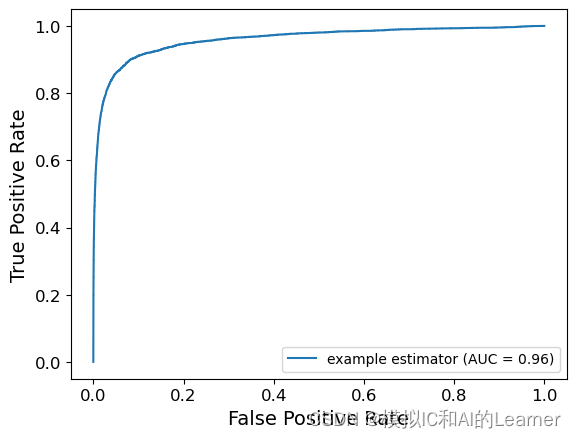
对于AUC的计算,上面使用了函数 auc() ,auc()函数可计算任意图像与x轴围成的面积,此处可用ROC_score专用函数 roc_auc_score() 来计算面积:
from sklearn.metrics import roc_auc_score
roc_auc_score(y_train_5, y_scores) #这里传入的参数并不是x、y的序列,函数内部会进行TPR和FPR的计算
#输出为:0.9598058535696421